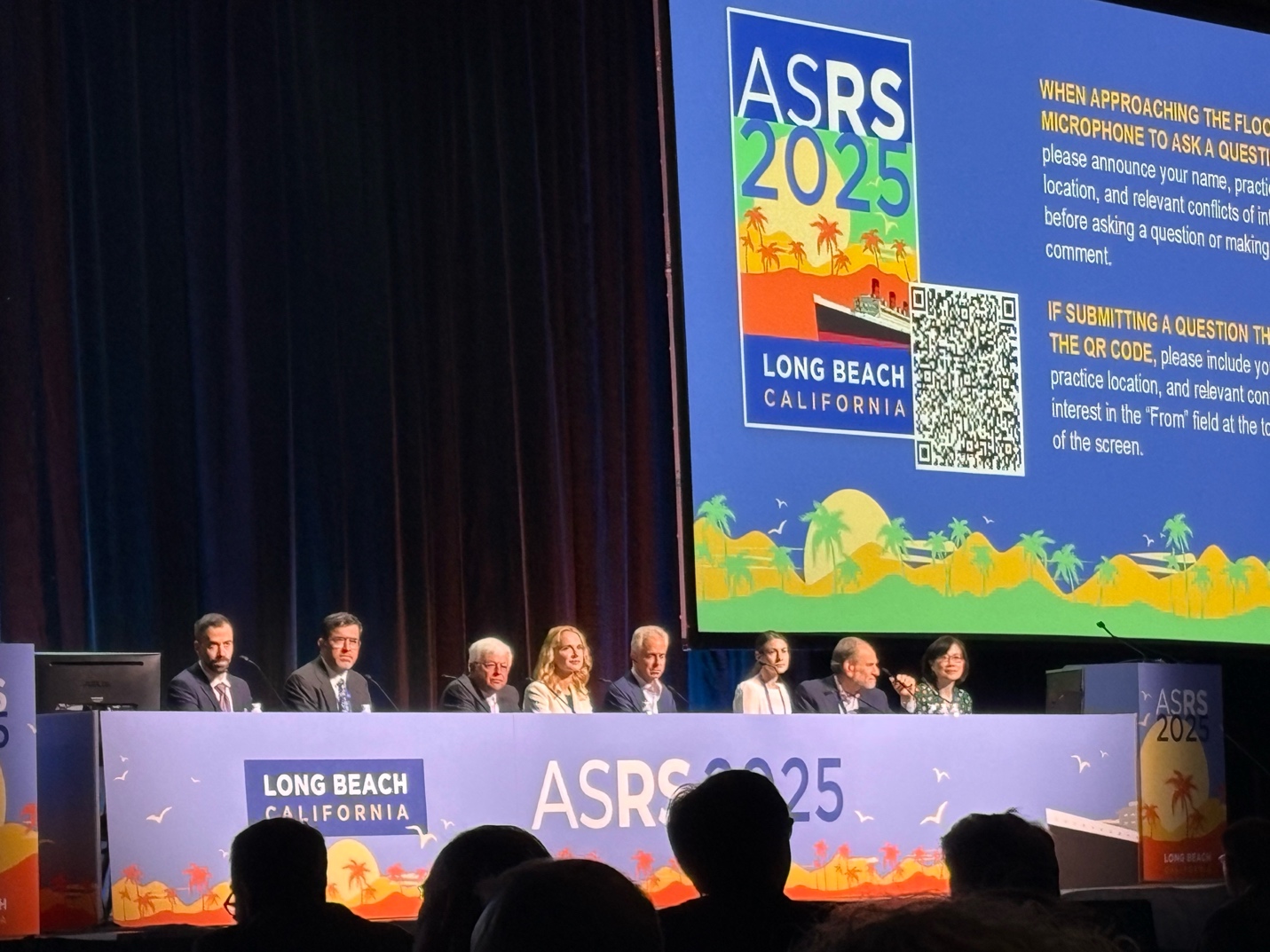Warren Pan, MD, PhD
Kellogg Eye Center, Ann Arbor, MI
The Dry AMD Session 3 at ASRS 2025 showcased groundbreaking clinical trials for geographic atrophy (GA) secondary to AMD, featuring novel therapies targeting complement inhibition, macrophage modulation, and gene therapy. Below are the key takeaways from the session. 
Biomarker-Based Efficacy Analysis of Intravitreal CFH Supplementation in a Phase 2 Trial
David M. Brown, MD (Retina Consultants of Texas)
The session began with a presentation by Dr. David Brown, MD, who presented on the Phase 2 trial of intravitreal CFH supplementation (recombinant human CFH GEM103) in the ReGATTA trial. Patients were stratified into three different groups based on baseline complement biomarkers as measured via anterior chamber paracentesis: hyperactive, homeostatic, and hypoactive. Eyes were then categorized into three GEM103 response profiles: therapeutic modulation, potential efficacy and ineffective CFH supplementation.
Of the total 62 eyes that were treated with GEM103, 48 were evaluable in terms of geographic atrophy at the time of injection and 6 months later. Geographic atrophy growth was found to be 42% slower (increase of 0.75 mm2 vs. 1.29 mm2) during this time period when comparing the hyperactive and therapeutic modulation subgroup against the ineffective CFH supplementation group. This neared statistical significance with p=0.06. Additionally, BCVA improved by 5 letters for the therapeutic modulation subgroup versus 0 letters for the ineffective CFH supplementation with a p=0.07. While statistical significance was narrowly missed, these findings suggest personalized complement therapy could be on the horizon.
![]()
Changes in Hyperautofluorescence Area and RPE/Outer Retinal Layer Thickness in the Phase 2a SIGLEC Study Assessing AVD-104 for the Treatment of GA
Carl D. Regillo, MD (Wills Eye Hospital)
The next talk featured Dr. Carl Regillo, MD, who discussed the Phase 2a SIGLEC study that examined AVD-104, a sialic acid-coated nanoparticle that modulates activated retinal macrophages and microglia, thereby repolarizing these myeloid cells into a neuroprotective state. Thirty patients with GA secondary to AMD received a single intravitreal injection of AVD-104 in one eye, with the fellow eye serving as a control. The injections were well-tolerated, with only one case of intraocular inflammation that resolved.
Eyes receiving 3.0 mg of AVD-104 experienced a significant decrease in junctional zone areas, as measured by mean hyper-autofluorescence area (p=0.02). Additionally, the change in maximum RPE thickness from baseline to month 3 was -4.24 mm in treated eyes compared to +3.44 mm in fellow eyes (p=0.04).
![]()
Deactivation of CD163+ Retinal Macrophages With AVD-104 Siglec Agonism Can Restore Photoreceptor Function and Vision in Geographic Atrophy
Eleonora M. Lad, MD, PhD (Duke University Medical Center)
Dr. Eleonora Lad, MD, PhD, also presented on AVD-104 in the SIGLEC Phase 2a study, but focused on center-involving GA. She elaborated that AVD-104 deactivates CD163+ peripheral blood-derived retinal macrophages. Eighteen patients with center-involving GA due to AMD were enrolled in this trial. In this study, nine patients received 1 mg of intravitreal AVD-104, and nine patients received 3 mg of intravitreal AVD-104. Three months after a single injection, the 1 mg cohort gained 4.8 letters, and the 3 mg cohort gained 6.5 letters. Additionally, OCT analysis demonstrated a slowing of GA lesion growth rate. Multifocal ERG was also performed on two eyes in the 1 mg cohort and four eyes from the 3 mg cohort with a significant improvement in response density in the junctional zone of 40.1% (p=0.01).
![]()
Safety, Tolerability, and Properties of Novel C3 Inhibitor BI-C in Patients With Geographic Atrophy
Brian B. Berger, MD (Brian B Berger, MD, PLLC)
Next, Dr. Brian Berger, MD, discussed the C3 inhibitor Bl-C, which is a high-affinity, high-potency C3 inhibitor that penetrates Bruch’s membrane. In this Phase I study, 20 patients received Bl-C with no drug-associated adverse effects, although three patients in the single rising dose and two patients in the multiple dose cohorts experienced mild ocular adverse effects. Aqueous sampling of free C3 found that Bl-C maximally inhibited free C3 at Day 1, with suppression still present at Day 56. Notably, Dr. Berger remarked that what differentiates Bl-C from other C3 inhibitors is its permeability across Bruch’s membrane, which should increase the effectiveness of the intervention.
![]()
Safety and Efficacy of OCU410, a Novel Modifier Gene Therapy, for Treatment of Geographic Atrophy: Phase 1/2 Study Update
Jay Chhablani, MD (University of Pittsburgh)
Dr. Jay Chhablani presented on OCU410, a gene therapy injected subretinally in patients with geographic atrophy. OCU410 delivers human RORA, a regulator of cellular homeostasis. The Phase 1 trial included 9 patients who received 200 ml of low (2.5 x 10^10 vg/mL), medium (5 x 10^10 vg/mL), or high (1.5 x 10^11 vg/mL) doses of OCU410 in the worse-seeing eye. Encouragingly, no adverse events were reported. Treated eyes demonstrated a 2-line (10-letter) improvement in visual function, as measured by LLVA, compared to untreated eyes. Treated eyes experienced a 27% slower geographic atrophy lesion growth compared to untreated eyes at month 9.
![]()
First Time Results of VOY-101, a Novel, Complement-Modulating Gene Therapy for Geographic Atrophy
Omer Trivizki, MD, MBA (Tel Aviv Medical Center)
Dr. Trivizki spoke on VOY-101, a complement-regulating gene therapy for the treatment of geographic atrophy. VOY-101 is a gene therapy delivered intravitreally and provides a “protective” CFH protein to the retina. Topical steroids with a 24-week taper were also given along with the injection. Current phase 1 results have followed the 24 patients given intravitreal VOY-101 over 465 days.
No serious adverse events, toxicities, CNVM, vasculitis, or retinitis were observed. Seven subjects did experience transient and mild anterior or vitreous inflammation. All were self-limited and managed with topical steroids without recurrence of the inflammation after completion of the steroid taper. No patients required systemic steroid therapy. Aqueous humor analysis demonstrated dose-dependent presence of the “protective” CFH transgene protein at 3 and 6 months.